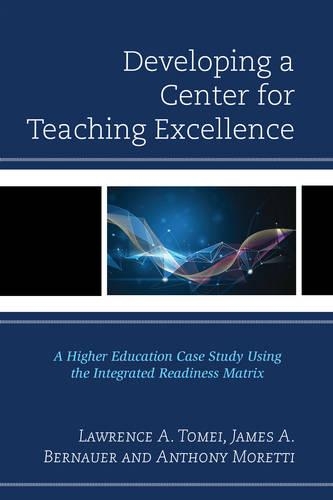
Developing a Center for Teaching Excellence: A Higher Education Case Study Using the Integrated Readiness Matrix
(Hardback)
Available Formats
Publishing Details
Developing a Center for Teaching Excellence: A Higher Education Case Study Using the Integrated Readiness Matrix
By (Author) Lawrence A. Tomei
By (author) James A. Bernauer
By (author) Anthony Moretti
Bloomsbury Publishing PLC
Rowman & Littlefield Publishers
30th September 2016
United States
Classifications
Professional and Scholarly
Non Fiction
Philosophy and theory of education
Teaching staff / Educators
Teaching skills and techniques
378.001
Physical Properties
Hardback
164
Width 157mm, Height 240mm, Spine 16mm
372g
Description
Developing a Center for Teaching Excellence: A Case Study Using the Integrated Readiness Matrix builds on the 2015 text, Integrating Pedagogy and Technology: Improving Teaching and Learning in Higher Education with a focus on teaching in higher education. Developing a Center for Teaching Excellence is premised on our contention in the first book that, while individual faculty members can independently begin to use the IRM to improve their pedagogical and technological skills in their content areas, an organizational structure is needed to sustain ongoing improvement. In addition, while the first book provided a primer on learning theory as it relates to pedagogy, Developing a Center for Teaching Excellence plumbs this topic more deeply from the perspective of the college instructor. Further, the second book is dedicated to demonstrating how the IRM can be institutionalized as the foundation for providing the structure and support to faculty and how they can help shape centers for teaching excellence by becoming more familiar with relevant learning theories and related pedagogical and technological approaches.
Reviews
Developing a Center for Teaching Excellence provides a sound model for launching a university/college Center for Teaching Excellence. Faculty development is an essential part of maintaining and improving teaching and scholarship in higher education, and the authors have created a useful tool and roadmap to follow that is results-oriented. The clear writing and numerous specific examples pave the way for improved pedagogical and technological expertise in the classroom. -- Sharon J. Sherman, dean, School of Education, Rider University
The Integrated Readiness Matrix (IRM) is a welcome tool in a world of ever-increasing, and changing, expectations for teaching and learning in higher education. This simple, but effective, tool can be used at both the individual and institutional level to determine the current status of knowledge and skills of faculty in regards to pedagogy and educational technology. Based on this analysis, sound plans can be made for building effective and efficient professional development plans and schedules. This book provides excellent case studies of the implementation of the IRM to help guide others new to this concept. Anyone charged with guiding faculty development at their college or university would be well served to have a copy of this practical and helpful text on their bookshelf. -- Fiona H. Chrystall Ph.D, director of Curriculum Quality Assurance and Assessment, Asheville-Buncombe Technical Community College
Author Bio
Lawrence Tomei is the Vice Provost for Academic Affairs and a Professor of Education at Robert Morris University in Pittsburgh, PA. Dr. Tomei has published numerous articles and books on instructional technology and education and is editor-in-chief of the International Journal of Information and Communication Technology Education. He is a US Air Force veteran and retired as a lieutenant colonel. Jim Bernauer is an Associate Professor in the School of Education and Social Sciences at Robert Morris University in Pittsburgh, PA. His major interests are learning and teaching in Pre-12 and higher education and research methodology. Anthony Moretti is the Director of the Center for Innovative Teaching and Directed Engaged Learning at Robert Morris University, where he also is an Associate Professor in the School of Communications and Information Systems. He earned his PhD from the E. W. Scripps School of Journalism at Ohio University.
